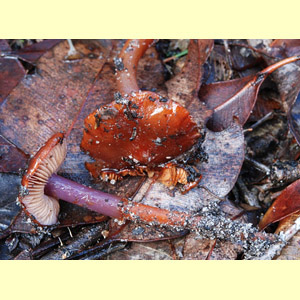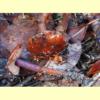
images/Phaeocollybia/FC_1378_Sp._598_Phaeocollybia_tasmanica_-_Robinson.jpg
Small to medium agarics, growing on the ground, with a rusty to ochre-brown, clay-brown or dark brown spore print. Pileus orange or brown (often greyish or dark brown), viscid or not. Lamellae free, adnexed, adnate or sinuate or notched, often with purple tints. Stipe central, with pseudorhiza. Partial veil remnants absent. Odour usually unpleasant. Spores yellow-brown, warty; plage sometimes present; germ pore absent. Cheilocystidia present, usually capitate. Lamellar trama regular. Pileipellis a cutis or a trichoderm. Clamp connections present or absent.
Species of
Oudemansiella (other) can have a pseudorhiza and a brown pileus, but the lamellae and spore print are white.
Gymnopilus and
Galerina are similar in micro-characters, but they lack a pseudorhiza, and the former rarely has purple tints (and then not on the lamellae). Moreover,
Gymnopilus usually grows on wood or larger litter, while
Galerina is either annulate or rather small and
Mycena-like with a honey (not dark) brown pileus. Some species of
Cortinarius are very similar in colouration, but that genus lacks a pseudorhiza, the partial veil is a cortina and cheilocystidia (if present) are never capitate. The odour of
Phaeocollybia is often rather unpleasant (such as like burnt hair).
Phaeocollybia R.Heim,
Inocybe 70 (1931).
Four species: Phaeocollybia australiensis (Canyonleigh, New South Wales, type locality only), P. graveolens (Denmark region, Western Australia, type locality only), P. ratticauda (with var. myrtaceophila) and P. tasmanica.
W.A., N.S.W., Vic. and Tas.
In native forests, including cool-temperate rainforest.
On the ground, with a pseudorhiza connected to deeply buried fine roots.
Ectomycorrhizal, according to Norvell (1998).
Fuhrer, B. (2005),
A Field Guide to Australian Fungi. Bloomings Books, Hawthorn. [
Description and
Illustration of
P. tasmanica and an unnamed species]
Fuhrer, B. & Robinson, R. (1992), Rainforest Fungi of Tasmania and South-east Australia. CSIRO Press, East Melbourne. [Illustration of P. tasmanica (as Phaeocollybia sp.)]
Norvell, L. (1998), Observations on development, morphology and biology in Phaeocollybia, Mycol. Res. 102: 615–630. [Includes discussion of ectomycorrhizal status.]
Rees, B.J. & Syme, K. (1999), A new species of Phaeocollybia from Western Australia, Australas. Mycol. 18: 5–9. [Description, Illustration and Microcharacters of P. graveolens]
Rees, B.J. & Wood, A.E. (1996), The genus Phaeocollybia in south east Australia, Mycotaxon 57: 97–116. [Description, B&W Illustration and Microcharacters of P. australiensis, P. ratticauda and P. tasmanica, and Key to species]
Rees, B.J. & Wood, A.E. (1999), Profiles of fungi. 106. Phaeocollybia australiensis, Mycologist 13: 132–133 [Description and Illustration of P. australiensis]



_sml.jpg)
